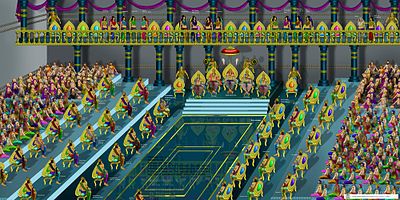Mamuni Mayan

Mamuni Mayan (மாமுனி Māmuṉi meaning Brahmarishi Mayan, Sangakala Sirpachithan Mamuni Mayan, Mayamuni, Mayendran) is a culture hero character from Tamil Sangam literature (the Silappathikaram, Manimekalai, and Civaka Cintamani epics), identified with the asura Maya Dānava (Mayasura) of the Mahabharata,[1] the mythical founder of Vastu Shastra. Romakapura (Sanskrit) [from romaka hairy + pura city, fortified town] City of hairy ones; in the Surya-Siddhanta (1:6; 12:39), is given as the birthplace of Asura maya.
In 2004 V. G. Sthapati started construction of a "monument to Mayan" near Mamallapuram.[2]
Mayan is credited with the authorship of the Mayamata Vastu Shastra as well as the Aintiram (Aindra, a school of grammar connected with the Tolkāppiyam). If there had been a grammatical treatise called Aintiram, it has been lost, but a text called Mayan's Aintiram dealing with Vastu Shastra was published by Sthapati in 1986, with the support of C. Aranganayakam, Tamil Nadu minister of education, and again in 1997 by the "Vaastu Vedic Research Foundation" with English commentary by S. P. Sabarathnam. MayaAsura is credited with the Surya Siddhanta,[3]
The 29 September 2003 edition of the Deccan Herald had an article on Mayan by R.R.Karnik,
The originator of all these ancient sciences is one known as Mayasura of the same tribe that constructed the mayasabha of Mahabharata. But the period is that of Ramayana some 16,000 years ago. He is the father of Mandodari and father-in-law of Ravana. One of his niece was Sita, who had married Rama and [by] an error of judgement started the epic war. He was master in many subjects. Some of these are: Vastu Shastra, Jyotirganita-Surya Siddhanta, Aintiram, ... cartography, fundamental physics, the Brahma principle, the yogashastra etc. His contribution to Aesthetics ... was highly appreciated by late Prof. [Surendra] Barlinge.
In 2006 Dr. V. Ganapati Sthapati asked Dr. Jessie Mercay, USA, to establish a small school - American University of Mayonic Science and Technology - in the US to teach authentic principles of Vaastu Shastra, Silpa Shastras and related texts including Mayan's Aintiram.
See also[]
- Kumari Kandam
- Pure Tamil
Literature[]
- Er. R. R. Karnik, Ancient Indian Technologies as Seen by Maya, the Great Asura
- Er. R. R. Karnik, Yuga, Mahayuga and Kalpa (1996) [1]
- S.P. Sabharathnam, Mayan's Aintiram : With Tamil Texts of Mayan and Paraphrasing with English Translation, Vaastu Vedic Research Foundation (1997), OCLC: 47184833.
- V. G. Sthapati, An overview of Mayonic Aintiram, Shilpi Speaks series 1 [2]
- Bruno Dagens, Mayamata : Traité Sanskrit d'Architecture, Pondichéry : Institut Français d'Indologie (1970), OCLC: 61978029.
- Bruno Dagens, Mayamata : an Indian treatise on housing, architecture, and iconography, Sitaram Bhartia Institute of Scientific Research (1985), OCLC: 15054108; Indira Gandhi National Centre for the Arts and Motilal Banarsidass (1994), OCLC: 60146035.
- Phanindra Nath Bose, Principles of Indian śilpaśāstra with the text of Mayaśāstra, Punjab Sanskrit Book Depot (1926), OCLC: 3354836.
- Aintir̲am, Directorate of Technical Education, Cen̲n̲ai : Tol̲il Nuṭpak Kalvi Iyakkakam (1986), OCLC: 19172544
- K S Subrahmanya Sastri; O A Nārāyaṇasvāmi Ayyar, Mayamatam, Śrīraṅkam : Śrī Vāṇī Vilāsam Patippakam (1888), OCLC: 13891788.
References[]
- ^ "The Mahabharata, Book 2: Sabha Parva: Section I". sacred-texts.com. Retrieved 13 April 2015.
- ^ "Vastu Vedic Trust | Vastu Vedic Trust". vastuved.com. Archived from the original on 25 October 2011. Retrieved 13 April 2015.
- ^ Translation of the Surya Siddhanta into English, by Bhāskarācārya, Bapu Deva Sastri, Lancelot Wilkinson, ISBN 3-7648-1334-2, ISBN 978-3-7648-1334-5, http://www.wilbourhall.org/pdfs/suryaEnglish.pdf
- Titles in India
- Asura
- Hindu temple architecture